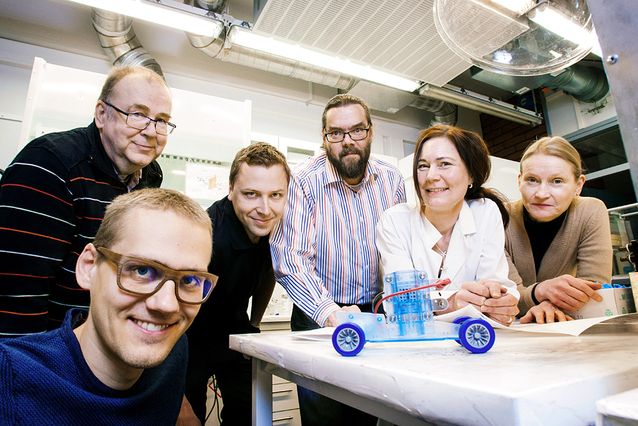New catalyst materials to boost the way to a more sustainable world

Catalysts materials under development by Helsinki Challenge team Supreme Catalyst could lead the way to a more sustainable world by providing more efficient ways for storing the energy from the sun and wind and by enabling the increased use of more sustainable raw materials, like water, biomasses and CO2, for the production of chemicals.
Catalysts are auxiliary chemicals which enable the efficient transfer of energy and chemicals from one form to the other. The lack of appropriate catalyst materials for energy storage is one the bottlenecks of the large scale application of renewable energy and of the adoption of new bio-based and secondary raw materials for the production of commodities.
The goal of Catalyst Supreme is to develop a whole new family of hybrid catalyst materials. We have started the work by developing a catalyst structure consisting of a metallic iron core covered by a carbon shell. Both iron and carbon are earth-abundant elements. Metallic iron is catalytically active but it is usually spontaneously oxidized in the atmospheric air, which results in the loss of its catalytic properties. In our hybrid catalyst the very thin carbon shell prevents iron from oxidation without ruining its catalytic activity. We have shown that this material can catalyse the electrochemical hydrogen production from water as actively as platinum, the best known catalyst material for this reaction. So far no other nearly as active non-noble metal material catalysts exists for this reaction.
Electrochemical production of hydrogen from water is one of the most important routes for the storage of renewable energy. Furthermore hydrogen is needed in the production of many essential chemicals (e.g. ammonia for food production fertilizers) and in several routes under development which recycle carbon by converting CO2 into chemicals, materials and fuels.
Our catalyst production is based on a novel in-house developed one-step synthesis method. In our method, both the catalytically active particles and their support are produced in the same process which hence is more efficient than multi-step alternatives. By changing the active metal in the catalyst core it is possible to develop various catalysts for different chemical reactions. Conventionally synthesis of hybrid catalyst materials involves several steps such as acid leaching and heat treatment
Our team combines theoretical and experimental expertise on material chemistry and electrochemistry to know-how on engineering, scale-up and communications and networking. Members include people from Aalto University, University of Oulu, Canatu Oy and Chemical Industry Federation of Finland.
Lisätietoja
Authors:
Tanja Kallio, Assoc. Prof., D. Sc.(Eng.), Department of Chemistry and Material Science, School of Chemical Engineering, Aalto University tanja.kallio@aalto.fi
Maija Pohjakallio, D.Sc. (Eng.), Senior adviser, circular and bioeconomy, Chemical Industry Federation of Finland, maija.pohjakallio@kemianteollisuus.fi
Helsinki Challenge is a science-based idea competition in which teams of scientists from ten Finnish universities work on solutions that help the humankind reach the UN Sustainable Development Goals (SDGs). Soon an international jury will choose 5-7 teams to continue in the accelerator programme. All of the 20 Helsinki Challenge semifinalist teams take the floor for the very last time at Helsinki Challenge Semifinal Pitch Nights 6.-7.6.2017. Catalyst Supreme is on stage, June, 6. Join us or follow the live stream and give your vote to boost us to be among the finalist teams. Most voted team proceeds straight to the finals:
Further information on Catalyst Supreme:
